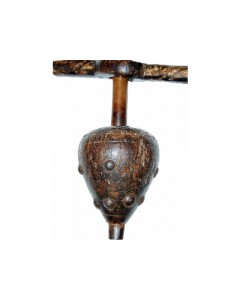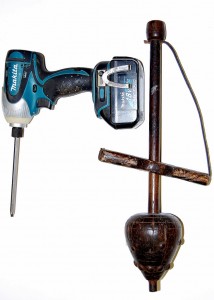Tools of the Weird: What if Faberge Made Tools?
A Most Egg-celent Drill
 The ornate wooden device in the photo may look like it was designed as a gift for Russian royalty, but it’s no mere ornament. It is actually a highly functional and surprisingly effective tool.
The ornate wooden device in the photo may look like it was designed as a gift for Russian royalty, but it’s no mere ornament. It is actually a highly functional and surprisingly effective tool.
When it was crafted 500 years ago in France, this pump drill was the very height of jobsite technology. The basic concept of the pump drill originated in Egypt long before this drill was produced. One of the cool things I noticed right away was that this drill foreshadowed modern technology by featuring a threadless chuck, of sorts. Bits were custom fabricated by the local blacksmith and employed a square-tapered tang (similar to the shank of a modern bit) that pressed into a matching hole in the bit holder and remained snugly in place.
How Does a Pump Drill Work?
Once the bit was in place and the user was ready to drill a hole, the tool was “wound” by spinning the brace, or handle, around the spindle until the strand of leather or string was wrapped tightly around the spindle. The user then placed the bit tip where the hole was needed. With a firm push with both hands down on the brace, the user forced the tool to unwind rapidly, spinning the bit into the wood and drilling a surprisingly clean and accurate hole, says tool historian John Sindelar, founder of the Sindelar Tool Museum.
The Sindelar Tool Museum
My friend Scott Hiller, a producer for DIY Network’s Cool Tools, introduced me recently to Sindelar’s collection after taping a segment for the show. He told me I’d be blown away, and he was right. The museum was established in Edwardsburg, MI almost 28 years ago to celebrate the spirit of human development and to showcase innovative solutions to unique problems. In some cases, as in the example of the pump drill, visitors will notice a feature that was designed to address a problem tool users may still encounter today. That’s when people realize we’re not really all that far removed from the craftsmen who were on the job four or five centuries ago. At the end of the day, the goal is still to be able to take pride in our work, and nowhere is this more evident over the course of history than in the way people designed their tools.
The museum’s collection now features thousands of tools of all shapes, sizes, purposes and countries of origin. And you don’t have to travel to Michigan to experience the museum for yourself. Some of the museum’s most important and inspiring items are on virtual display at Sindelar Tool Museum. One of the most stunning examples from the Sindelar collection is this exquisitely adorned plow plane. Look for additional items from the Sindelar Tool Museum collection in upcoming installments of Tools of the Weird. And special thanks to John Sindelar for his generous offer to help with this week’s edition and many more in the future!
About the author
Disclosure
Product reviews on this site contain our opinion of a product or service. We will always strive for objectivity and transparency in our reviews. Our goal is to provide readers with honest, objective information based on our own experiences. We never have and never will accept payment in exchange for a positive review. Many of the products that we review are provided to us for free by a manufacturer or retailer. In some cases, we also have advertising or affiliate relationships with manufacturers and retailers of products and services we review. For additional information please visit our additional disclosure policies.























